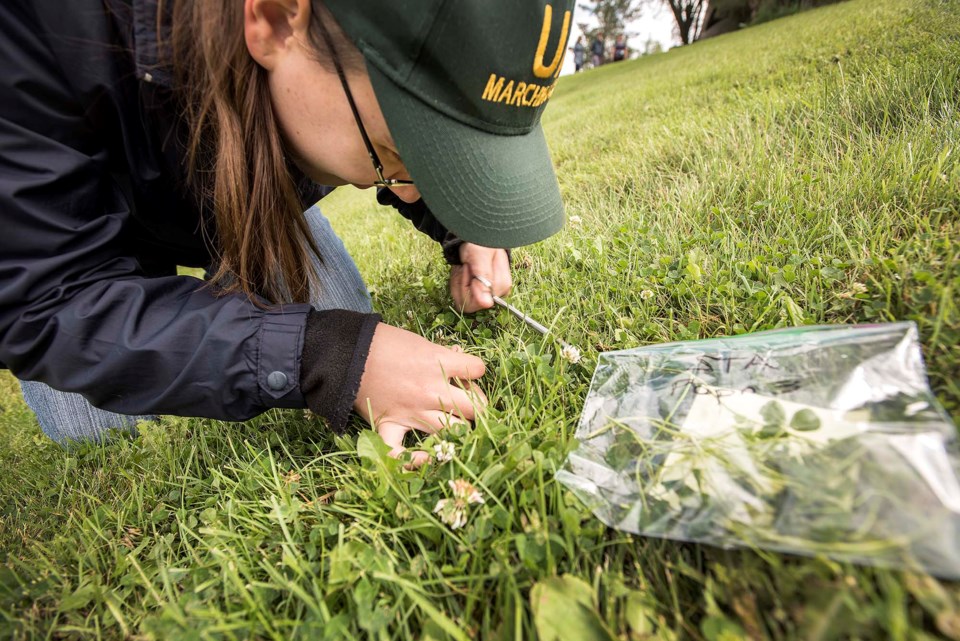Shamrocks selected by a St. Albert scientist were part of an international study released last week on how cities drive natural selection.
MacEwan University biologist and St. Albert resident Leah Flaherty was one of the 287 authors of a study published in Science March 18 on how global urban environmental change drives adaptation in white clover.
The study saw hundreds of researchers from around the world analyze white clover to try and figure out how cities affect evolution. Co-ordinating them was lead author and University of Toronto PhD student James Santangelo.
“Cities happen to be one of the most destructive forms of land-use change in the world,” Santangelo said, which means they can be potential drivers of evolution.
Santangelo decided to study evolution using white clover, as it is found everywhere humans live due to its common use on farms.
Previous research by study co-author Marc Johnson in select North American cities found rural clovers are more likely to produce hydrogen cyanide (thought to be a defence against drought and hungry herbivores) than urban ones, with cyanide levels dropping as you move further out of town. Johnson thought these changes were due to differences in winter nighttime temperatures, but later studies involving more cities seemed to contradict these results.
St. Albert shamrocks
Johnson and Santangelo decided to take their study global. From 2016 to 2019, they used Twitter and email to recruit 287 researchers in 160 cities in 26 countries to collect clovers along a downtown to out-of-town transect. The roughly 110,000 clovers they collected were mashed, put in water, covered with detector strips, and cooked at 37 C for three hours — if the strips turned blue, the clovers under them contained cyanide. Researchers then sent their data to Santangelo for analysis.
Flaherty led the St. Albert wing of what was dubbed the Global Urban Evolution Project (GLUE). Her students collected clovers from 40 sites between Lions Park and Starkey Road northeast of the Sturgeon Valley Golf and Country Club on Aug. 13, 2018, and analyzed them in a lab.
“This was remarkable opportunity for our students to contribute to research,” Flaherty said, and a memorable experience for many of them.
Surprising results
The study found 47 per cent of cities showed a noticeable urban-rural difference in their clovers, with the odds of cyanide production rising 44 per cent as you moved from downtown to the furthest rural edge. No real difference was found in St. Albert.
Researchers ruled out temperature, snow cover, and genetic diversity and identified drought and vegetation volume as the most likely explanation for this difference. Drought seemed to give cyanide-making clovers an edge over others, and rural areas in the study had more cyanide clovers when they were drier than urban ones. Herbivores also dislike cyanide, so where you have herbivores, such as in vegetation-rich rural areas, the study found more cyanide-making clovers (as the herbivores ate the cyanide-free ones).
“We have known for a long time that humans are potent drivers of natural selection,” Santangelo said, but this study is the most potent demonstration of this fact yet.
Santangelo said he was surprised temperature did not play a role in cyanide levels globally. He is not sure why St. Albert’s clovers did not have an urban-rural cyanide divide.
Santangelo said this study could help us better manage rare or pest species in cities. It has also spawned about eight spin-off studies.
“White clover is the dominant species available to pollinators in urban environments around the world,” he noted, and we don’t yet know how these evolutionary pressures are affecting them or urban ecosystems.
“That could have profound effects on the kinds of [ecosystem] services humans depend on.”
Flaherty said this study gives people an opportunity to see the value and uniqueness in urban ecosystems.
“There are interesting things about the natural world happening all around us, even in the middle of the city.
Visit www.globalurbanevolution.com for details on the study.




